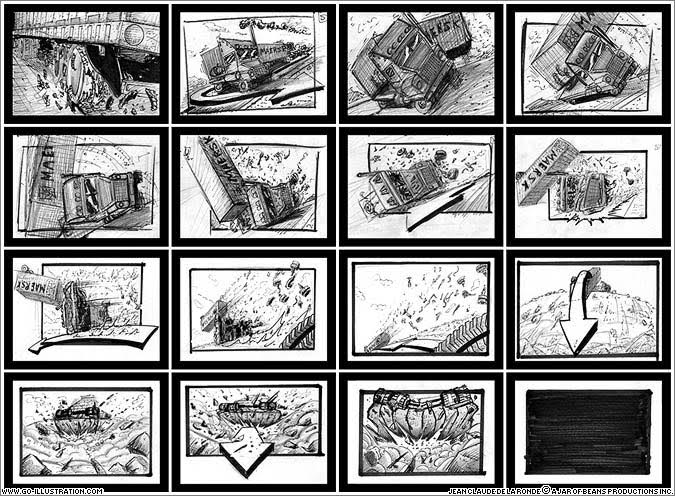We asked Montreal-based storyboard artist Jean Claude De La Ronde why storyboarding (pre-visualization) is so important to the filmmaking process.
“The storyboards are the building blocks,” he says, “for ‘building a film or any video game cinematics or even TV advertisements from the ground up’. They are literally a crucial visual reference point to all the departments involved in the project.”
Scene by Scene
 “A storyboard’s main purpose,” says De La Ronde, “is telling the story scene by scene and helping the director proceed with the multiple camera action sequence. It also helps to establish the proper camera angles to maximize the desired shot/shots sought by the director.
“A storyboard’s main purpose,” says De La Ronde, “is telling the story scene by scene and helping the director proceed with the multiple camera action sequence. It also helps to establish the proper camera angles to maximize the desired shot/shots sought by the director.
“But it has so much more value in terms of production costs, VFX shots to be done, and other useful information for all the artists that are involved on the project. And it also serves the purpose of letting everyone involved in the project know where we are at, what has been done so far, and where we are headed in the following days of production.”
Storyboards and Financing
De La Ronde says that the storyboard also is an asset when presenting to potential financiers who would be interested in investing money in the project. “They have the ability and the chance to visually see how the final product could look like at the end and have a pretty good idea of the story flow and pacing as well.”
Working from the Script
The script is key to De La Ronde’s work. That, and constant interaction with the project’s director. “I constantly work from a script. And the input from the director is mostly every day.
“I basically sketch the shots out, send him the results and get feedback from him. At this point I either rework the shots by adding details, or redraw sketches from a different viewpoint. It’s a ‘ball game’ really, LOL: constantly throwing back some sketches and receiving the feedback.
Visualizing
 Storyboard artists need to be able to “see” what is in the script. De La Ronde says, “The more you are exposed to any visual medium, the better. In my case the most important mediums were both comic books and movies. You have to be able to study and understand why certain shots work better than others. You have to be able to understand visual composition, values, perspective, storytelling, pacing and story flow.
Storyboard artists need to be able to “see” what is in the script. De La Ronde says, “The more you are exposed to any visual medium, the better. In my case the most important mediums were both comic books and movies. You have to be able to study and understand why certain shots work better than others. You have to be able to understand visual composition, values, perspective, storytelling, pacing and story flow.
“These are all art fundamentals for the most part, and the more you practice those building blocks, the better you will be able to pull off on paper what you see in your mind’s eye. It’s practice and patience, LOL… and passion!!! That really helps you learn faster and quicker.”
Multimedia Projects
De La Ronde says that, with storyboarding, the process of developing interactive/multimedia projects doesn’t really differ from film at its core structure.
“Where it can start to be tricky is if you are doing storyboards for cartoons. The storyboards at that level need to be more ‘clean and tight’ visually respecting the looks of the characters, and making sure that the information on each board, like the sequence number of the scenes, is carefully respected and clear to read.
“You need to make sure that your transitions between certain shots are carefully planned out in order to avoid redundancy and, most importantly, to never miss a deadline! Boards for animation will certainly be sent overseas for the hard core animation drawings, and if at this level your boards are not clearly understandable then problems occur. That isn’t a good thing for a lot of people in the production pipeline.
“Storyboards for live action sets like movies and TV shows are more focused on making sure that the camera catches the shots in dynamic ways and telling the story more creatively through creative camera positions.”
Here’s a link to some of his work on deviantart.com.
And another link to behance.net.
Here’s another sample of De La Ronde’s storyboarding:

